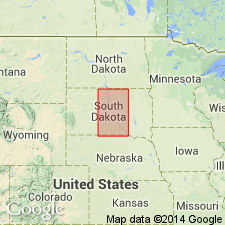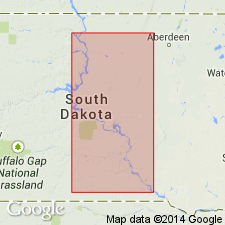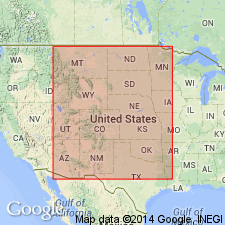
- Usage in publication:
-
- Elk Butte member
- Modifications:
-
- Named
- Dominant lithology:
-
- Shale
- AAPG geologic province:
-
- Williston basin
- Sioux uplift
Summary:
Pg. 50-55, pls. 2, 3. Elk Butte member of Pierre formation. Includes all beds in South Dakota between top of Mobridge member (new) and base of Fox Hills formation. Essentially medium-gray flaky shale with small ferruginous concretions. Thickness 70 to 290 feet. At type section consists mostly of light-medium-gray shale with gumbo-producing beds, 65 to 85 feet and 130 feet from base; contains small, light-medium-gray porous concretions 40 feet below top and pieces of concretions 20 feet above base; is sandy in top 10 feet. Age is Cretaceous. Gives additional sections (in Zieback and Gregory Counties), and shows outcrop along Missouri River Valley, South Dakota (Williston basin and Sioux uplift).
Type locality: along U.S. Highway 12, near Elk Butte, Corson Co., SD. Section begins a little less than 1.5 mi west and continues to 5 mi west of Wakpala. Named from Elk Butte.
[Discrepancy: GNU records (USGS DDS-6; Denver GNULEX, Jan. 12, 1987) state thickness of Elk Butte ranges from 60 to 130 feet, and at type section thickness is 310 feet.]
Source: US geologic names lexicon (USGS Bull. 1200, p. 1230); supplemental information from GNU records (USGS DDS-6; Denver GNULEX).

- Usage in publication:
-
- Elk Butte member*
- Modifications:
-
- Principal reference
- AAPG geologic province:
-
- Sioux uplift
- Williston basin
Summary:
Pg. 2338, 2340 (table 1), 2342 (fig. 1). Elk Butte member of Pierre shale. Predominantly gray shale; includes a non-calcareous shale at base. Thickness 270 feet. Top member of Pierre shale. Overlies Mobridge member of Pierre; underlies Fox Hills sandstone. Type section designated. Age is Late Cretaceous.
Type section: roadcuts along Federal Highway 12, between 1.5 and 5 mi west of Wakpala, eastern Corson Co., SD. Named from Elk Butte in eastern Corson Co., SD.
Source: Publication.

- Usage in publication:
-
- Elk Butte shale member*
- Modifications:
-
- Biostratigraphic dating
- Overview
- AAPG geologic province:
-
- Williston basin
- Salina basin
Summary:
Member of the Pierre shale, central SD and northeastern NE in Williston and Salina basins. Shows ammonite zonation and correlation with other stratigraphic units in the Western Interior region. Late Cretaceous (Maestrichtian) in age.
Source: GNU records (USGS DDS-6; Denver GNULEX).
For more information, please contact Nancy Stamm, Geologic Names Committee Secretary.
Asterisk (*) indicates published by U.S. Geological Survey authors.
"No current usage" (†) implies that a name has been abandoned or has fallen into disuse. Former usage and, if known, replacement name given in parentheses ( ).
Slash (/) indicates name conflicts with nomenclatural guidelines (CSN, 1933; ACSN, 1961, 1970; NACSN, 1983, 2005, 2021). May be explained within brackets ([ ]).

